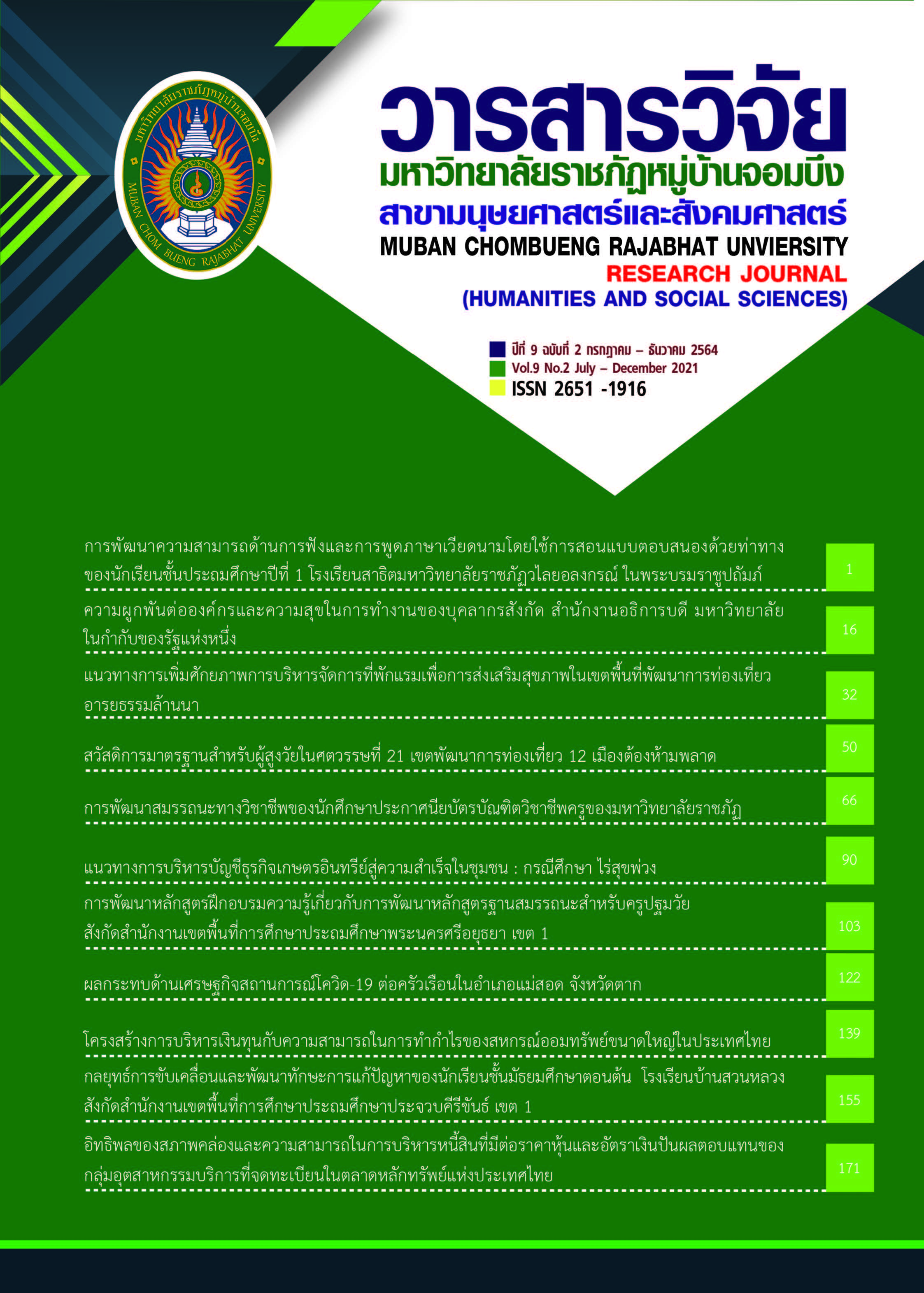Organizational Commitment and Happiness at Work of the Employees at Office of the President in an Autonomous University
Keywords:
Organizational commitment, Happiness at work, Office of the presidentAbstract
The purposes of this research are to (1) compare organizational commitment classified by personal factors (2) study factors affecting to organizational commitment, and (3) study relationship between organizational commitment and happiness at work. The research instrument was the questionnaire. The sample size was 130 employees at office of the president in an autonomous university. Statistics for data analysis were frequency, percentage, mean, standard deviation, independent sample t-test, F-test, stepwise multiple regression analysis and pearson’s product moment correlation coefficient.
The research results of analysis revealed that (1) the sample with different gender and department differently affect organizational commitment with a statistically significant level of .05. (2) work security, relationship with colleagues and leadership affect organizational commitment with a statistically significant level of .05. The predictive powers at 56.00 percent and the forecasting equation of raw score as Y = 0.77 + 0.382 (X4) + 0.289 (X5) + 0.151 (X2). (3) organizational commitment has significant positive correlation with happiness at work at level of .01 (r=0.660). The result of this research can be used as a guideline in the human resource management practice to increase organizational commitment and happiness at work among employees that would be benefit for both of employees and organization, as the engaged employees seem to have good mental and desirable behavior that effect to organization performance.
References
2. จิระพร จันทภาโส. (2558). ความผูกพันต่อองค์การของข้าราชการครูและบุคลากรทางการศึกษาในวิทยาลัยเทคนิคหาดใหญ่ จังหวัดสงขลา. ปริญญานิพนธ์บริหารธุรกิจมหาบัณฑิต, มหาวิทยาลัยหาดใหญ่. สงขลา.
3. เฉลิมขวัญ เมฆสุข และประสพชัย พสุนนท์. (2560). ปัจจัยคุณภาพชีวิตการทํางานที่ส่งผลต่อความผูกพันต่อองค์กรของพนักงานระดับปฏิบัติการบริษัท สยามฟิตติ้งส์ จํากัด. วารสารธุรกิจปริทัศน์, 9(1), 33-50.
4. ชินกร น้อยคำยาง และปภาดา น้อยคำยาง. (2555). ปัจจัยที่ส่งผลต่อดัชนีความสุขในการทำงานของบุคลากรในสำนักหอสมุดกลางมหาวิทยาลัยศรีนครินทรวิโรฒ (รายงานผลการวิจัย). มหาวิทยาลัยศรีนครินทรวิโรฒ. กรุงเทพฯ.
5. นิตยา บ้านโก๋. (2558). ปัจจัยที่มีผลกับความผูกพันต่อองค์กรของบุคลากรภาครัฐศูนย์ฝึกพาณิชย์นาวี กรมเจ้าท่า กระทรวงคมนาคม. ปริญญานิพนธ์รัฐศาสตรมหาบัณฑิต, มหาวิทยาลัยธรรมศาสตร์. กรุงเทพฯ.
6. บุญชม ศรีสะอาด. (2543). การวิจัยเบื้องต้น. พิมพ์ครั้งที่ 6. กรุงเทพฯ: สุวีริยาสาส์น.
7. พรรณพนัช ไตรรัตนนุกูล. (2554). ความสัมพันธ์ระหว่างความสุขในการทำงานและความผูกพันต่อองค์กรของพนักงานในบริษัท ไอ.โอ.เทคนิค จำกัด. ปริญญานิพนธ์บริหารธุรกิจมหาบัณฑิต สาขาวิชาการประกอบการ, มหาวิทยาลัยศิลปากร. นครปฐม.
8. ลลิตา จันทร์งาม. (2559). ปัจจัยที่ส่งผลต่อความผูกพันต่อองค์การของพนักงานธนาคารออมสิน สำนักงานใหญ่ กลุ่มลูกค้าบุคคล. ปริญญานิพนธ์รัฐศาสตรมหาบัณฑิต, มหาวิทยาลัยธรรมศาสตร์. กรุงเทพฯ.
9. วรารักษ์ ลีเลิศพันธ์. (2557). ปัจจัยที่มีผลต่อระดับความผูกพันต่อองค์กรของพนักงานบริษัท เนชั่น บรอดแคสติ้ง คอร์ปอเรชั่น จำกัด (มหาชน). ปริญญานิพนธ์บริหารธุรกิจมหาบัณฑิต, มหาวิทยาลัยเนชั่น. ลำปาง.
10. สายสุนีย์ เบ็ญจโภคี. (2559). การสำรวจความผูกพันต่อองค์การของบุคลากรสถาบันแห่งชาติเพื่อการพัฒนาเด็กและครอบครัว. วารสารการพัฒนางานประจำสู่งานวิจัย, 3, 53-62.
สุกรรณิการ์ เจียมคงอยู่. (2550). การรับรู้วัฒนธรรมองค์การที่มีผลต่อความผูกพันต่อองค์การของข้าราชการพยาบาลโรงพยาบาลตากสิน. ปริญญานิพนธ์บริหารธุรกิจมหาบัณฑิต สาขาวิชาการจัดการ, มหาวิทยาลัยศรีนครินทรวิโรฒ, กรุงเทพฯ.
อนันต์ มณีรัตน์. (2559). ความผูกพันในองค์การ ศึกษากรณี สำนักเลขาธิการคณะรัฐมนตรี. ปริญญานิพนธ์รัฐประศาสนศาสตรมหาบัณฑิต, จุฬาลงกรณ์มหาวิทยาลัย. กรุงเทพฯ.
อภิชาติ ภู่พานิช. (2551). การใช้ดัชนีวัดระดับความสุขในการทำงานของบุคลากรสังกัดสำนักงานอธิการบดีมหาวิทยาลัยธรรมศาสตร์. ปริญญานิพนธ์สังคมสงเคราะห์ศาสตรมหาบัณฑิต, มหาวิทยาลัยธรรมศาสตร์. กรุงเทพฯ.
อาริญา เฮงทวีทรัพย์สิริ. (2558). ความผูกพันต่อองค์การ บุคลิกภาพห้าองค์ประกอบ และความสุขในการทำงานของพยาบาล โดยมีพฤติกรรมการเป็นสมาชิกที่ดีขององค์การเป็น
ตัวแปรสื่อ: กรณีศึกษาโรงพยาบาลมหาวิทยาลัยในกำกับของรัฐแห่งหนึ่ง. ปริญญานิพนธ์ศิลปศาสตรมหาบัณฑิต สาขาวิชาจิตวิทยาอุตสาหกรรมและองค์การ, มหาวิทยาลัยธรรมศาสตร์. กรุงเทพฯ.
Allen, N. J., & Meyer, J. P. (1990). The measurement and antecedents of affective, continuance, and normative commitment to the organization. Journal of Occupational Psychology, 63(10), pp. 1-18.
Cronbach, L. J. (1970). Essentials of psychological testing. 3rd Edition. New York: Harper & Row.
Hinkle, D.E. (1998). Applied Statistics for the Behavior Sciences. 4th Edition. New York: Houghton Mifflin.
Manion, J. (2003). Joy at work: Creating a positive workplace. Journal of Nursing Administration, 33(12), 652-655.
Steers, R.M., & Porter, L. (1991). Motivation and Work Behavior. New York: McGraw- Hill.
Steers, Richard M. (1977). Organizational Effectiveness: Behavioral View. Santa Monica California: Goodyear Publishing Company In.
Taro Yamane. (1973). Statistics: An Introductory Analysis. 3rd Edition. New York: Harper and Row.
Warr, P. (1990). The measurement of well-being and other aspects of mental health. Journal of Occupation Psychology. 63 (3), 193-210.
Downloads
Published
How to Cite
Issue
Section
License
Journal of TCI is Licensed under a Creative Commons Attribution-NonCommercial-NoDerivatives 4.0 International (CC BY-NC-ND 4.0) licence, unless otherwise stated, Please read our Policies page for more information on Open Access, copyright and permissions.



